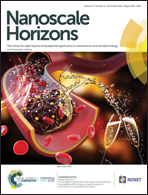Fe3O4–Pd Janus nanoparticles with amplified dual-mode hyperthermia and enhanced ROS generation for breast cancer treatment†
Abstract
Developing multifunctional theranostic nanoplatforms with high tumor therapeutic efficacy is the focus area of nanomedicine. In this study, we have designed Fe3O4–Pd Janus nanoparticles (JNPs) with dual-mode magnetic resonance imaging/photoacoustic (MRI/PA) imaging properties for magnetic-photo hyperthermia and chemodynamic therapy simultaneously. Due to the magnetic-photothermal properties of Fe3O4 nanoparticles and plasmonic photothermia effect of Pd nanosheets, the combined Fe3O4–Pd JNPs can achieve synergistic heating effects of 1 + 1 > 2. It is demonstrated that Fe3O4–Pd JNPs reached a higher temperature enhancement under alternating magnetic field (AMF) plus laser irradiation than the corresponding individual modality (only AMF or laser irradiation alone for Fe3O4–Pd JNPs) or the sum of two individual modalities. Besides amplified magnetic-photo heating, Fe3O4–Pd JNPs also enhanced ROS generation due to the interface synergistic effect in producing hydroxyl radicals (˙OH), which is realized by Fe3O4 nanoparticle-based Fenton reaction and Pd nanosheet-based catalytic properties in the presence of H2O2 in an acidic environment. Remarkably, the ROS level could be further elevated under external AMF plus laser irradiation. The in vivo anti-tumor effect of Fe3O4–Pd JNPs was evaluated on a 4T1 orthotopic mouse breast cancer model. The results showed that Fe3O4–Pd JNPs enable complete tumor inhibition without appreciable adverse effects under AMF plus laser irradiation, guided by MRI/PA dual-mode imaging with a high spatial resolution and accuracy. This study provides an alternative way for cancer therapy by on-demand design of high-performance theranostic nanoplatforms according to the characteristics of the tumor microenvironment and the intriguing physiochemical properties of inorganic nanomaterials.

- This article is part of the themed collections: Top articles from NCNST, Research selection from the NCNST and Nanoscale Horizons Most Popular Articles


 Please wait while we load your content...
Please wait while we load your content...